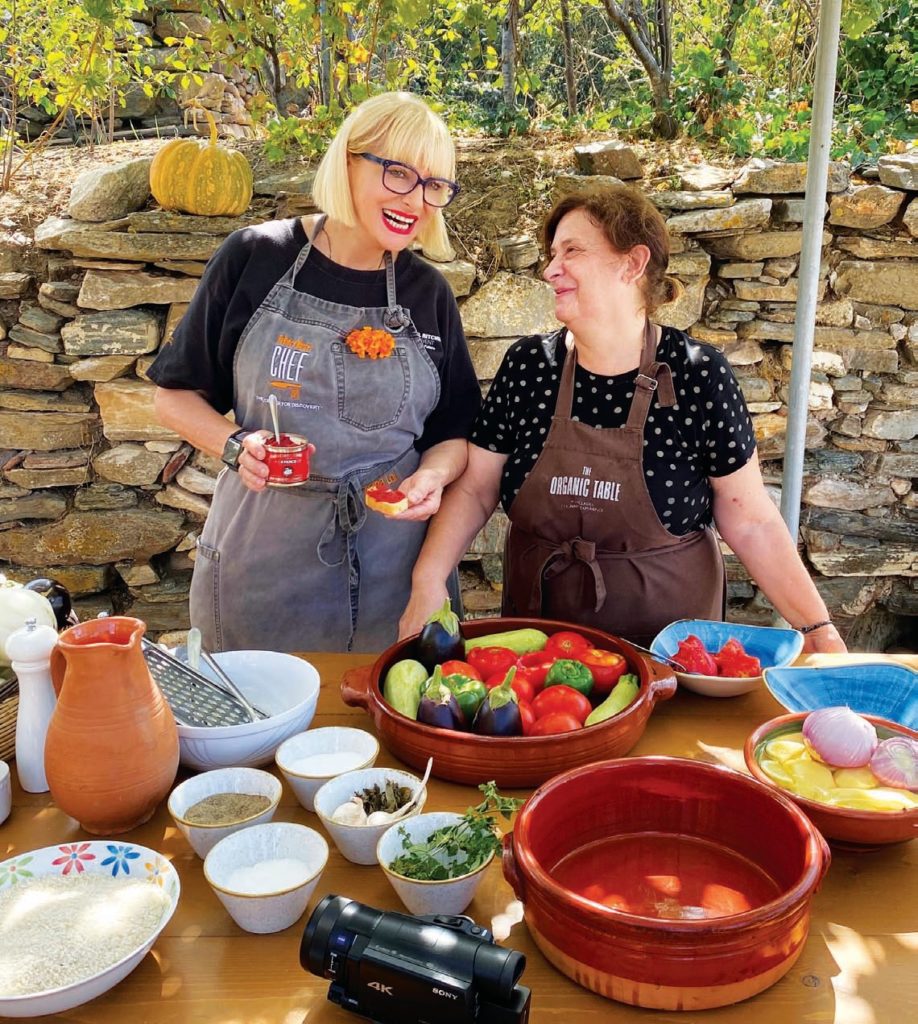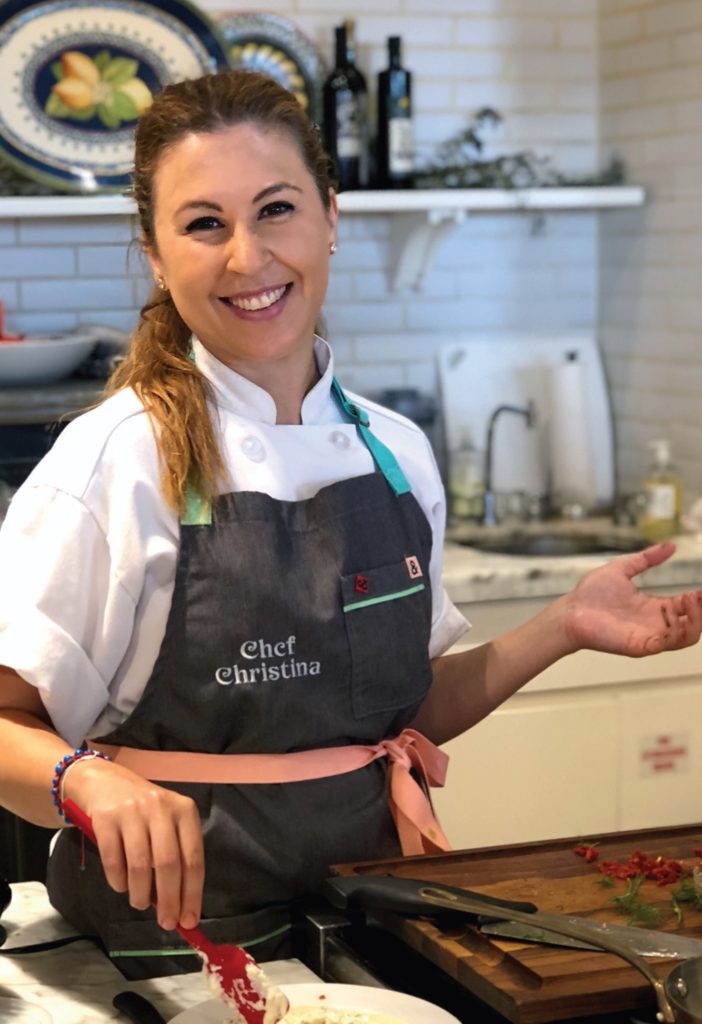The Road Ahead
Posted by estiator at 10 December, at 07 : 29 AM Print
COVER STORY
From robot servers to popular proteins, the trends industry leaders say will dominate 2022.
By Michael Kaminer
Some in our industry have described 2021 as a roller coaster. Estiator readers have a different take. They’ve told us it’s been more like a Tilt-a-Whirl, bumper cars, and Whack-aMole rolled into one.
With that in mind, we’re proud to present our annual roundup of forecasts from the Estiator community and other industry leaders. As 2022 dawns, how do we stay optimistic? How do we look beyond supply-chain issues, hiring challenges, and third-party-delivery strife to continue delivering memorable food and experiences to customers we love?
You’ll find answers in the wisdom, experience, and forethought we’re proud to share from some of the most respected restaurant, hospitality, and business professionals in the country. And most importantly, from the Estiator family to yours, Χαρούμενα Χριστούγεννα κι ευτυχισμένος ο καινούριος χρόνος!

For 2022, we need to work on changing the way we eat, and make sure we are skewing healthier—specifically, incorporating more legumes and beans like lentils, chickpeas, etc., into our regular diet so that we begin following a more Greek-Mediterranean way of eating. And of course, using olive oil for everything, not only because it is a delicious and dynamic component and ingredient, but because it is full of polyphenols, which can lower many health risks (including diabetes, cardiovascular disease, and our cholesterol), and increase longevity and quality of life. Olive oil makes life taste better…and healthier!
—Chef Maria Loi, restaurateur, entrepreneur, healthful-eating advocate (loiestiatorio.com)
2020, 2021, 2022…it’s all a blur, and time has flown by! But I see 2022 being the year we return to normalcy. We will see a lot of new restaurants come to life and open in pandemic shut-down spaces. New talent and concepts will emerge. People will eventually feel safe, and we will begin hugging and shaking hands all while eating and drinking next to strangers.
—Demetri Tsolakis, owner, Greco (grecoboston.com), Committee (committeeboston.com), Krasi (krasiboston.com), Boston


The past few years have been difficult for this industry, as we faced many challenges since the start of the pandemic. But at this point, it seems that we’re finally seeing a light at the end of the tunnel. Throughout the past three months, we’ve seen an increase in activity between all sectors of commercial leasing. As this year is coming to an end, it’s clear that retail, fitness, office, and restaurants have all made a strong comeback. We expect this trend to continue in quarters 1 and 2 of 2022 and ultimately expand more than it ever has prior.
—James Famularo, president, Meridian Retail Leasing, New York City

At Showmars, we’re optimistic. Prior to COVID, and throughout the pandemic, we made adjustments to our model that have served us well. We put tech pieces in place to serve our communities online and with deliveries. Into 2022 and beyond, I predict these will lead the way. We’re continuing to open new locations, including two in downtown Charlotte.
As far as supply-chain issues, they’re challenges we all face. We make adjustments day to day, minute by minute in the field. But we’re managing it well. We’ll continue to watch those trends and see where they take us.
On Showmars’ menus, proteins have been very good for us. We’ve added a few more entrées with proteins, predominantly chicken. Vegetables have been a mainstay, and we’ll continue to evolve in that direction. “Healthy” is a really good place for all of us in the industry to be. But people continue to look for value. Customers want value for their money.
—Dean Peroulas, CEO, Showmars (showmars.com), Charlotte, NC

The world labor and supply-chain challenges will continue to have considerable impact on restaurants through the third quarter of 2022. Working with our key suppliers and vendor partners with a longer time horizon, for the vision of our brand needs, has never been more important than now.
In 2022, as markets experience higher menu prices and daily cost of living escalates, the consumer’s continued desire to eat fresh, healthy, and flavorful food will certainly increase the stakes for restaurants competing for the consumer food dollar. Brands like The Great Greek Mediterranean Grill, which is focused on delivering an exceptional overall experience to its customers, will separate from the pack and thrive. In 2022, restaurant executives and operators who deploy the proper investment in user-friendly technology and convenient food-delivery options will enjoy increased customer loyalty. The Great Greek Mediterranean Grill is investing our time and money in areas that our customers tell us they want. When it comes to convenience, the most important factors are easy mobile and online ordering, more catering options, as well as walk-up and drive-thru pickup windows.
—Bob Andersen, president, The Great Greek Mediterranean Grill (thegreatgreekgrillfranchise.com)

For many operators, 2022 will most likely bring record-setting sales numbers. For those of you who like to throw sales numbers around, 2022 will most likely be your favorite year. Your operation could break all of your previous sales records.
However, before you get too excited, for operators who don’t pay attention to all their numbers and adjust things accordingly, 2022 can bring losses, even with having higher than ever sales.
How is that possible, you ask? Higher costs— for labor, for food, and for everything else we need to operate our restaurants.
No matter in what part of the country you are located, we all know that finding good employees is very difficult, and it doesn’t look like that challenge is going to change anytime soon. High demand with low supply automatically means higher prices. If that isn’t enough, many states, including Illinois, where our restaurant is located, will have to pay the new minimum wage of $12 per hour beginning January 1st.
We all know the supply-chain challenges that we have to deal with. Once again, that supply-and-demand equation kicks in and we will have to endure higher costs for just about everything we use.
With higher labor and food costs, we will have no option but to raise prices. The sales numbers will look great going forward until all the bills have to be paid. Our hope is that there will be money left over to pay the higher utility bills and higher taxes and money left over to pay ourselves.
Gear up for your “to go” business. The demand for take-out will continue to increase. The operators who have taken the necessary preparations will do very well. What are the necessary preparations? Online platforms with plenty of pictures of your food that make it easy and convenient for customers to place their orders. Packaging is very important. In my opinion, it’s worth paying that extra $.25 to $.50 for the sturdy, better-quality container and raise your menu price accordingly. Most customers will not remember the extra 50 cents they paid on a $10 item, but they will remember if their food was cold or spilled inside the bag.
I am an optimist. As restaurant operators, we will always face challenges of one kind or another. I believe that communities are looking to support their local hardworking, independent restaurants. Our challenge is to “step up our game” so we can provide them with quality products and great customer service at reasonable prices that will keep them coming back for more.
—Steve Theofanous, president, GARC Restaurant Cooperative (GARC purchasing.com), and co-owner, Around the Clock restaurant, Crystal Lake, IL
As we continue to feel the impact of climate change in our daily lives, eating and drinking sustainably has become more important than ever. Whereas “sustainability” is now an almost meaningless word in the NYC restaurant landscape and splashed across the news, Amali’s true pledge to green practices began a decade ago, when we welcomed diners to enjoy Slow Food-certified cuisine sourced from organic practicing, family-run farms and Dock-to-Dish seafood on pine tables reclaimed from our predecessor’s excavation.
Amali is known for its depth of Greek wine offerings. Greece, ever a favorite of natural-wine lovers, has been on the forefront of organic and biodynamically made wines for its thousand-plus years of production. One of our favorite wine picks is Domaine Neranzi’s Koniaros, a long-lost indigenous varietal cultivated in pesticide-free soil strewn with ancient Greek pottery. Another favorite is the Great Mother by Stilianou (named for the mother goddess of the ancient Minoans)—organic, low-sulfite, and not filtered or fined.
The tide is slowly turning for domestic producers, too. Once known for its oak-chipped, high-sulfite, high-intervention wines, the American wine world has a few stars turning out well-made natural wines. One of our favorites is La Garagista from Vermont, where Deirdre Heekin (the fairy godmother of American natural wines) makes limited production biodynamic cuvees from hybrid varietals. Another is Troon in Oregon, where biodynamically made Rhone varietals thrive in a land typically known for its Pinot Noir.
As more and more people understand the environmental impact of unsustainable living, we hope that these types of naturally made wines and forward-thinking oenologists continue to gain popularity across the world. Winemakers who respect the terroir not only make wines that taste better—they’ll make you feel better too (lower additives and sulfites = less likelihood of a killer wine hangover). Please join us in toasting to a deeper commitment to a cleaner future.
—Kylie Monaghan, partner, Civetta Hospitality (Amali, Juniper, Bar Marseille, and Calissa), New York

The devastation on the restaurant industry also created an opening for a reassessment of options, as well as a cleanup of the operations. Options such as starting over in a more business-friendly market was considered by many. Others expanded to such markets, while some left the industry entirely. In the markets where the most closures occurred, there were by default the most vacancies available in otherwise major markets. And therein lies my prediction for 2022.
In 2022, for those operators in the devastated markets who managed to survive, expect to see a brief period of limited competition—possibly through Q2. During that time, however, know with certainty that new brands and new operators will be securing and building businesses to launch in Q3 and Q4. The mass amount of vacancies means excess supply, which necessarily means lease terms will be more attractive in order to increase demand and fill the vacancies. Those new operators are starting fresh, with clean and organized systems and processes, no lingering labor and employment liabilities, and no deferred rent and other loans to pay back. In addition, expect to see successful operators from those business-friendly markets who thrived during the pandemic to expand into those devastated markets.
In response, as I’ve said many times throughout the pandemic, the time is yesterday to reset and revamp your operations if you are one of those who survived. Compliance (also known as “the stuff that keeps you up at night”) should be front and center in all operators’ minds and efforts. Getting your house in order is step 1 always. From there, you can leverage the best that the industry has to offer—technology, marketing, trends, etc.
My other prediction for 2022 is that you will see more quality food and beverage offerings. Consumers have undeniable built-up demand to go out. They also have a lot more savings. They will be more likely to “treat themselves” more so than pre-pandemic. They will buy the slightly more expensive bottle of wine; they will eat out more than once a week; they will host more events and gatherings at venues and restaurants; and, most importantly, they will be looking to catch up on memory-making, because they need to in order to dilute the memories from the pandemic. These are all good things for restaurant owners and operators, so long as you focused on step 1 first, and then moved on to evaluating your offerings to meet these demands. And don’t be afraid to eliminate the offerings of the past that may have been loved but were not profitable. Certainly don’t be afraid eliminate the “excess fat” in your offerings that drove up your food cost and labor. Be focused in your offerings, and show your market that you, too, are new. Consumers may rush back to their old favorites, but they will also quickly look at the new offerings from your new competitors around you.
Finally, don’t forget the reality that many people retired during the past 20 months; many changed their lives entirely and relocated their lives to somewhere far away. Do not assume that everything will ever go back to what it was. Assume—and prepare—for the opposite.
Good luck to all of us, and I am always available for the readers of Estiator to meet for coffee and chat in person. No more Zooms, though, because this is the hospitality industry—not the technology industry!
—Andreas Koutsoudakis, founding partner, Koutsoudakis & Iakovou Law Group (kilegal.com), and owner, Tribeca’s Kitchen (tribecaskitchen.com)

For 2022 our industry will continue to struggle with staffing and sourcing inventory, and prices will continue to trend upwards, which will pressure our already thin profit margins. Products and equipment that are environmentally friendly are expected to be introduced in the near future, and customers will continue to look for organic and healthier options in our menus. As a long-term prediction, I believe that in the next 10 years, our diets will consist of 100% plant based foods to limit animal-to-human-transmitted viruses.
—Sakis Tyrnas, board president, Pan-Gregorian Enterprises of Upper New York (pgeuny.com), and owner, Capital City Diner, Albany, NY

I think the labor shortage will encourage the use of robots to supplement the workforce. A PGE UNY member has one, and I just read an article in The New York Times about a Florida chain restaurant using one (Servi). The waiter robot is in beta stage, but as capital/demand starts flowing to this product category, it will get better, rapidly. I am a technologist. The use of robots in restaurants is right up my alley. I am going to explore this in 2022 for our members.
—Lisa Marcinelli, business consultant, Pan Gregorian Enterprises of Upper New York (pgeuny.com)
As we head into 2022, the restaurant industry is hoping the post-pandemic era will begin soon. They are dealing with dual hit of labor and supply-chain issues that will continue into the new year. Savvy restaurateurs will continue to seek out sensible tech options such as pay-at-table and QR code solutions tailored to their business and to their guest desires.
—Barbara Castiglia, executive editor, Modern Restaurant Management (modernrestaurantmanagement.com)
We predict that 2022 will bring continued growth, recovery, and innovation to the hospitality industry. We have an opening planned for estiatorio Milos in Dubai at Atlantis the Royal, following our 2021 openings at The Venetian Resort in Las Vegas and at the first Milos Hotel in Athens. Diners, who have become accustomed to takeout and delivery, are increasingly eager to dine out again and have a restaurant experience. We believe global travel will continue to grow in the New Year. And while we evolve at Milos with our new locations, the heart of our business remains philoxenia, the art of Greek hospitality.
—Tanja Yokum, VP Marketing and Public Relation, Estiatorio Milos
My clients are changing menus two or three times a year as opposed to once every year or two. They need to absorb the continually rising food and labor costs. I’m guessing things may stabilize some time late next year. But I see somewhat higher food costs and definitely higher labor costs.
—Tom Stavrakis, founder, Restaurant Graphics, rgmenus.com

Looking ahead, I see that carryout and delivery will continue to grow. Traditional dine-in establishments, many of which were forced to adapt by the pandemic, will need to continue to make to-go a larger part of their business. Operators should plan for increasing government restrictions on to-go packaging creating more challenges in keeping up with the changes and where to source product. The straw ban recently took effect in NJ, and May of 2022 will bring more restrictions on foam containers and bags. With the labor shortages continuing, you will see operators closing one or two days a week in order to give their loyal, hardworking staff time off, something that would have never been a thought three or four years ago! Another regular occurrence will be the reduction of hours or even eliminating dayparts.
The good news is people have to eat, and enjoying a good meal with friends and family will be a part of our lives forever. But don’t be surprised if your juicy steak is served by a robot real soon!
—Rick Aurite, president, Delaware Valley Purchasing Group (dvpgroup.com)
I think 2022 will follow the current trajectory as far as focusing on health and sustainability. People will continue to move away from red meat—or at least become more thoughtful as to where the meat they eat comes from. Interest in plant0based alternatives will continue to grow. (I just saw vegan feta in the cheese case at Trader Joe’s.) In step with that, I think mushrooms will continue to be in the spotlight. Mushrooms are fantastic meat alternatives. Some mushrooms are also adaptogens, which think are moving into the mainstream and becoming more available as well. Look for more superfoods from the sea as well. I think algae, kelp, kombu, spirulina, etc., will continue to grow in popularity. In addition to that? I can tell you people are still sick of cooking for themselves, so they will continue to look for alternatives to that, either by purchasing ready-made foods or food subscriptions, or hiring a personal chef to take care of the meal planning and cooking for them.
—Christina Xenos, founder, Sweet Greek Personal Chef Services (mysweetgreek. com), Los Angeles















